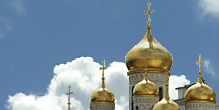 |
 |

|
 |
 |
QUESTION:
What is the Orthodox belief regarding the "Sacrifice of the Mass?" Is it the same as Roman Catholicism or different? Could you please explain the similarities and differences? Thank you.
ANSWER:
Thank you for your inquiry.
The Divine, or Eucharistic, Liturgy of the Orthodox Church recalls, as one prayer from the Liturgy states, "all those things which have come to pass for us: the Cross, the Tomb, the Resurrection on the Third Day, the Ascension into Heaven, and the Second and Glorious Coming. ..." The Liturgy is not so much a reenactment of the Mystical Supper or these events as it is a continuation of these events, which are beyond time and space. Unlike many of the Protestant bodies, the Orthodox also see the Eucharistic Liturgy as a bloodless sacrifice, during which the bread and wine we offer to God become the Body and Blood of Jesus Christ through the descent and operation of the Holy Spirit, Who effects the change.
As far as the order of the Liturgy, it follows the same basic outline as the Roman Mass -- introductory psalms, scripture readings and homily, offering, Eucharistic Kanon and Epiklesis [Consecration], commemorations, the Lord's Prayer, Holy Communion, and closing prayers with final blessing. However, the Liturgy that is generally celebrated is that of Saint John Chrysostom, which is much, much older than the order of the Mass currently in use among Roman Catholics and the Tridentine Mass that had been used prior to Vatican II.
Published in January 2011.
Read more Christian articles
Recommend this page to your friend!
|
 |
 |

| Read also: |
|
|

|
|

